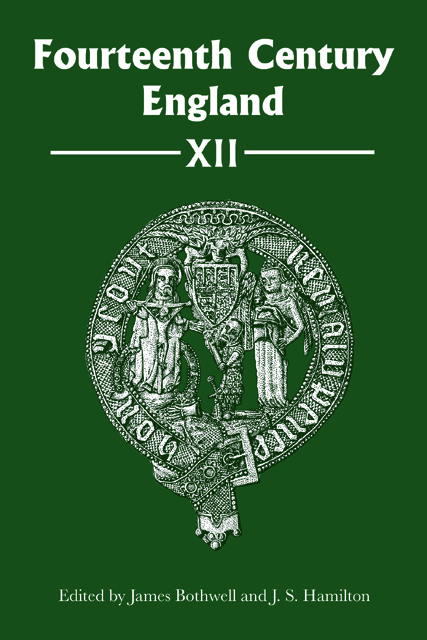Book contents
- Frontmatter
- Contents
- List of Illustrations
- List of Contributors
- Preface
- Abbreviations
- The King’s Confessors and the Royal Conscience in Late Medieval England
- ‘Such maintenance as …’: Corrodies of the Crown
- ‘Vos maisons sount pris al eops le counte’: Walter Bedwyn, Treasurer of York, and the Return of Piers Gaveston
- The Deposition of Edward II: The Kenilworth Embassies
- The English Parliament and the Trial of the ‘Peers of the Land’ in Henry of Lancaster’s Revolt (1328–29): The Origins of a Privilege
- A Brotherhood Uncovered: Investigating the Knightly Following of Thomas Beauchamp, earl of Warwick, 1329–69
- The Black Death and Clerical Prospects in England
- The Last of the Duketti? Richard II, Henry of Monmouth and the House of Lancaster
- Confusion Confounded? The Contrasting Military Fortunes of Sir William Neville (d. c.1391) and Sir William Neville of Pickhill and Rolleston (d. c.1420)
‘Vos maisons sount pris al eops le counte’: Walter Bedwyn, Treasurer of York, and the Return of Piers Gaveston
Published online by Cambridge University Press: 11 January 2023
- Frontmatter
- Contents
- List of Illustrations
- List of Contributors
- Preface
- Abbreviations
- The King’s Confessors and the Royal Conscience in Late Medieval England
- ‘Such maintenance as …’: Corrodies of the Crown
- ‘Vos maisons sount pris al eops le counte’: Walter Bedwyn, Treasurer of York, and the Return of Piers Gaveston
- The Deposition of Edward II: The Kenilworth Embassies
- The English Parliament and the Trial of the ‘Peers of the Land’ in Henry of Lancaster’s Revolt (1328–29): The Origins of a Privilege
- A Brotherhood Uncovered: Investigating the Knightly Following of Thomas Beauchamp, earl of Warwick, 1329–69
- The Black Death and Clerical Prospects in England
- The Last of the Duketti? Richard II, Henry of Monmouth and the House of Lancaster
- Confusion Confounded? The Contrasting Military Fortunes of Sir William Neville (d. c.1391) and Sir William Neville of Pickhill and Rolleston (d. c.1420)
Summary
Over Christmas [of 1311], which Edward spent at Westminster, he appears to have decided to trust both his own fate and that of Gaveston to the north of England. Edward set out from Westminster soon after Christmas and on 8 January 1312 arrived at Knaresborough in Yorkshire, where he was joined by [Gerard] Salveyn on 13 January. It is highly probable that Salveyn was accompanied by Gaveston […] It is likely that the king then rushed to York as soon as Gaveston joined him …
In these words, Seymour Phillips, in his masterly biography of King Edward II, described the return from exile of Piers Gaveston, earl of Cornwall, in the winter of 1311–12, and the beginning of the final act in a story which ended in the death of the king’s favourite the following June. In examining Gaveston’s reunion with the king, Phillips, like other authors such as Pierre Chaplais and John Maddicott before him, used and cited one particular document, which he described as a ‘draft newsletter’, and which recounts events in Yorkshire at this tumultuous time. However, it is clear that the identities of both the writer and the intended recipient of that letter, neither of which is specified in the text, have been misunderstood for many years, and although it does not necessarily change the value of the information contained within the letter, understanding its origins does help to put the document, and its relevance, into greater context.
The letter itself is far from being the most impressive document in The National Archives’ collections. Measuring just 22cm by 15cm, its dorse is blank apart from a few scribbles, while the text on the face, written in Anglo-Norman French, begins some way from the top of the page and runs right down to the foot, before the sheet of parchment was turned round and a further six lines were added in the remaining gap, upside-down to the original text. These additional lines, and the final three lines of the main block of text, contain the details of national political events, suggesting that the author may have added them as something of an afterthought or addition to the main content of his letter.
- Type
- Chapter
- Information
- Fourteenth Century England XII , pp. 47 - 64Publisher: Boydell & BrewerPrint publication year: 2022



